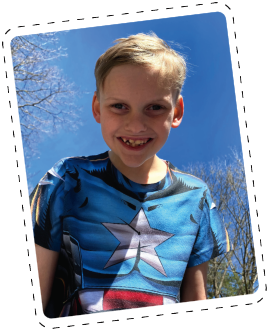Welcome to the
(Video) Library

REAL PEOPLE TAKING LIVMARLI
Hear from real patients and their families as they share their unique experiences—life before diagnosis, challenges before starting LIVMARLI, and the difference LIVMARLI is making in their lives.*
*Not all patients taking LIVMARLI will have the same experiences.


Meet Tyler
Tyler spent the first 10 years of his life battling constant itching and relying on ineffective treatments before finally finding relief.
[00:00:00]
[music]
Terisa: My name is Terisa. I have 3 boys. The oldest, Brian, is 14, Tyler is 10, and Benny is 5. [00:00:30] I think that being a mom is probably what my calling's been. I love being their mom. I love being just involved with raising them, and it's what I've always wanted to do. I've always wanted to have kids. I didn't really know what I wanted to do with work. I just knew I wanted my job to be being a mom.
The most rewarding thing is just watching them grow up, just seeing their different personalities, and they're so unique. They all have their own character traits, their own interests. Tyler's hobbies are swimming, playing basketball, [00:01:00] throwing the ball around with his brothers, he likes to do that, likes to cook with me. We like to just hang out and watch movies and videos and he loves video games. That's his favorite thing right there.
When I was pregnant with Tyler, they did a very thorough check, the 18-week fetal survey, just to be proactive since I was born with a heart condition. That's when they found the hole in his heart and some issues, and they diagnosed him prenatally with [00:01:30] Tetralogy of Fallot. He was born at 39 weeks and everything looked good, and they took an X-ray of his heart and that's when I saw the butterfly vertebrae, which is now knowing that that's the first marker that we found for Alagille syndrome. And then, he went home, and we just were looking forward to surgery day and that was it.
He started getting really jaundiced even though he was eating really well. The pediatrician had just run some basic bilirubin tests and he was [00:02:00] really high, but he didn't think it was dangerously high to send him to the hospital. We were going back and forth between cardiology for a week and then pediatrician for a week just to make sure his heart was stable until he was ready for surgery. The morning of pre-op, they just threw on a liver function panel test just to see if the bilirubin dropped.
Next thing you know, surgery's canceled and he is whisked upstairs for a liver ultrasound. Then, that's where they were able to diagnose the bile duct paucity. [00:02:30] They went right from there and clinically diagnosed him with Alagille syndrome.
[music]
When he was diagnosed with Alagille syndrome, I just remember standing there and everything spinning around me. [00:03:00] I just felt like I was in this tornado of like, "What? This just happened to me? I just did everything you told me to do and now I have this diagnosis."
[music]
The light in the tunnel there was finding the Alagille support page and finding people that were going through exactly what I was going through and being able to also connect with families that had the same age child as my kid. It was great to see adults and say, [00:03:30] "Wow, these kids have a future." Ironically, it felt very comforting to have someone on my side.
[music]
Learning about bile acids through the Alagille support page, I realized that that was a big factor to his itch. Basically, your liver has no natural flow of the bile, so it just reabsorbs and it's going through your bloodstream, so everywhere your blood is from head to toe [00:04:00] is going to be itchy. I started noticing him rubbing his eyes a ton. It was more than just the hunger cues, more than the tired cues, and so we went back into another pediatrician and asked, “What's going on?” They said, "No, it's not allergies. He's got to go through a whole season before it's diagnosed as allergies." It was just brushed off as, "We don't know what that is."
The itch was getting worse and every time we did a diaper change, he was scratching at his legs or his diaper area and then rubbing the eyes [00:04:30] constantly. That was the big thing for him. Then, it moved into putting toddler socks on his hands so that they went all the way up to his arms; that way, at night, he wasn't digging into his ears and making them bleed everywhere. The itch kind of normalized for us. We just knew it was there, but at the same time, we really kind of discredited a lot of the itch and a lot of the liver involvement to just being mild, even though we later learned that it was [00:05:00] much more severe than mild.
It just was changing bedsheets consistently, bandaging up all the cuts. Unfortunately, grieving the fact that I couldn't do the bed sharing and the cuddling with Tyler because he sweats so much and then it made him more itchy. Then, trying to sleep with him, he was tossing and turning and rolling and scratching, and I was like, "I can't do this. I'm not sleeping. He's not sleeping." Naps were few and far between. Just was never settled for a nap time because he was so itchy and there was no [00:05:30] medications out there at the time for Tyler to take that actually worked for him to relieve that itch.
Tyler: The itch is just bad. It's horrible and it keeps me from doing stuff. The itch just feels like an itch, a bug bite, or something. But then, it goes from here to your back, and then goes all over, and then you can't stop.
[music]
[00:06:00]
Terisa: We had learned that LIVMARLI was getting close to being FDA approved and we were very excited about something being an option for him again. We worked with our doctor [00:06:30] and got him on LIVMARLI. Tyler was a good candidate for LIVMARLI because he had Alagille syndrome, but then he had that very persistent pruritus. When he turned 10, he started LIVMARLI and that was great. It was a really fun day for him because it was his birthday, but also it was kind of the start of what could be his new normal, not itching as much as he had been.
On his 10th day was when we started realizing he's sleeping through the night. He's not tossing and turning. [00:07:00] There had been no new scabs, no bandages on his arms and legs. That was a sight to see to not have the bandages so much, but then also just to see him sleeping and his brothers sleeping because they all shared a room and they weren't being woken up by him tossing and turning so much. Once his doctor prescribed LIVMARLI, we got connected with the Mirum Access Plus Program and they got it right on our doorstep in less than 2 months.
It's been nice to not have to be chasing down doctors [00:07:30] for refills and going to the pharmacy to pick things up. It's just so convenient having it right to our door. One side effect that we've been battling is GI cramping. That's just something that we knew it was a possibility of this happening and we had to work with our doctor to make sure that we could manage this for him and let it be so that he could still attend school and do his daily activities. [00:08:00] I think he's great now. I mean, we're going strong on 10 months in. What do you think?
Tyler: I think we're doing good.
Terisa: You feel good on the medicine?
Tyler: Yes.
Terisa: I know 10 years is a long time, but I'm glad he wasn't 20 and he just got his hands on this. I wish it could have been sooner for him, but I'll take 10 years and then the rest of his life.
Tyler: Having Alagille syndrome doesn't really make me feel [00:08:30] much different. It just makes me feel like myself because it doesn't affect what's on the outside. It mostly affects what's on the inside. Now that I'm on LIVMARLI, I'm itching less and I'm sleeping better.
Terisa: There's people out there that are willing to connect and happy to connect and make sure that you feel supported through your journey because at the beginning, it can be very overwhelming and you can feel like you're drowning, but there's light on the other side and there's [00:09:00] a possibility of having happiness as part of your every day.
[music]
Narrator:
INDICATION
LIVMARLI is indicated for the treatment of cholestatic pruritus in patients who are 3 months of age and older with Alagille syndrome.
IMPORTANT SAFETY INFORMATION
CONTRAINDICATIONS
LIVMARLI is contraindicated in patients with prior or active hepatic decompensation events (eg, variceal hemorrhage, ascites, or hepatic encephalopathy).
WARNINGS AND PRECAUTIONS
Hepatotoxicity: LIVMARLI treatment is associated with a potential for drug-induced liver injury. In the Alagille syndrome trial, treatment-emergent elevations of liver tests or worsening of liver tests occurred.
Obtain baseline liver tests and monitor during treatment. Liver-related adverse reactions and physical signs of hepatic decompensation should also be monitored. Dose reduction or treatment interruption may be considered if abnormalities occur in the absence of other causes. For persistent or recurrent liver test abnormalities, consider treatment discontinuation. Permanently discontinue LIVMARLI if a patient experiences the following: persistent or recurrent liver test abnormalities, clinical hepatitis upon rechallenge, or a hepatic decompensation event.
Gastrointestinal (GI) Adverse Reactions: Diarrhea and abdominal pain were reported as the most common adverse reactions. Monitor for dehydration and treat promptly. Consider reducing the dosage or interrupting dosing if a patient experiences persistent diarrhea or has diarrhea with bloody stool, vomiting, dehydration requiring treatment, or fever.
Fat-Soluble Vitamin (FSV) Deficiency: Patients can have FSV deficiency (vitamins A, D, E, and K) at baseline, and LIVMARLI may adversely affect absorption of FSVs. If bone fractures or bleeding occur, consider interrupting LIVMARLI and supplement with FSVs. LIVMARLI can be restarted once FSV deficiency is corrected and maintained at corrected levels.
Risk of Propylene Glycol Toxicity (Pediatric Patients Less Than 5 Years of Age): Total daily intake of propylene glycol should be considered for managing the risk of propylene glycol toxicity. Monitor patients for signs of propylene glycol toxicity. Discontinue LIVMARLI if toxicity is suspected.
ADVERSE REACTIONS
The most common adverse reactions are diarrhea, abdominal pain, vomiting, FSV deficiency, liver test abnormalities, and bone fractures.
DRUG INTERACTIONS
Administer bile acid binding resins at least 4 hours before or 4 hours after administration of LIVMARLI. A decrease in the absorption of OATP2B1 substrates (eg, statins) due to OATP2B1 inhibition by LIVMARLI in the GI tract cannot be ruled out. Consider monitoring the drug effects of OATP2B1 substrates as needed.
DOSING INFORMATION
LIVMARLI should be taken 30 minutes before a meal. The provided oral dosing dispenser must be used to accurately measure the dose. Any remaining LIVMARLI should be discarded 100 days after first opening the bottle.
[music]
[00:12:40] [END OF AUDIO]
Root Out
Excess Bile
Learn how LIVMARLI—the first FDA-approved treatment for cholestatic pruritus in Alagille syndrome—battles bile acid buildup.1
See How LIVMARLI Works
Encourage patients to download the Itch✓ app to help them track symptom patterns over time and generate customized reports to share at appointments.
Check Out the Itch✓ App
Mirum Access Plus assists both you and your patients at every turn, helping you navigate the payer approval process—and beyond—with ease.
Learn More AboutMirum Access Plus

